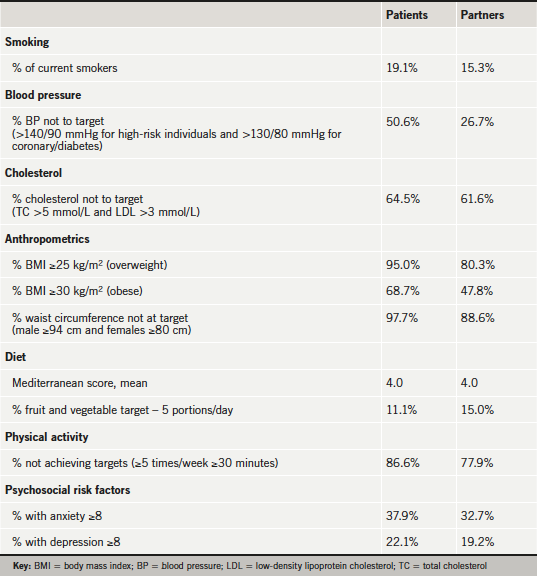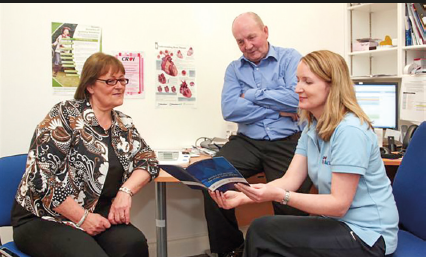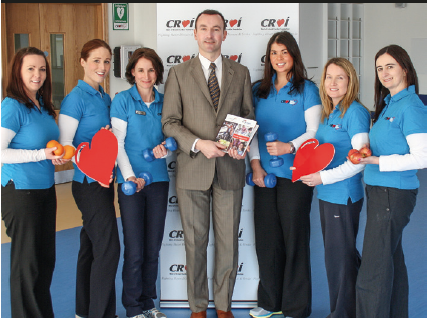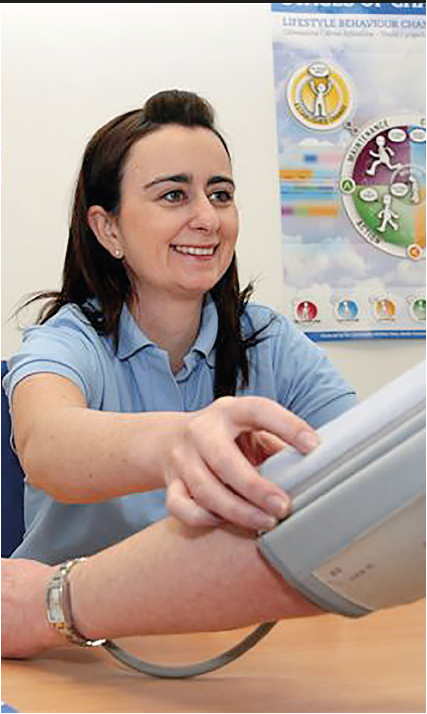Background
Cardiovascular disease (CVD) is the single most common cause of death in Ireland, with diseases of the circulatory system accounting for 33.5% of deaths.1 While there has been a significant decline in death rates over the last 30 years, CVD mortality rates in Ireland remain high in comparison with European averages.2 There is compelling evidence that managing risk factors through lifestyle intervention and cardioprotective drug management can reduce cardiovascular morbidity and mortality by up to 90%.3 In Ireland, high-risk approaches to prevention have traditionally targeted those with established heart disease, yet there are many asymptomatic individuals with multiple risk factors whose risk is similar to those who have overt heart disease but go unrecognised. With a high prevalence of risk factors in the Irish population,4,5 the need to develop an effective model of prevention that would include asymptomatic individuals at high multi-factorial risk was urgent. In response to this need, Croí, an Irish heart and stroke charity, wanted to develop an effective, evidence-based intervention that would help individuals reduce their CVD risk. In 2009, following a successful business case submission to Galway Primary Community and Continuing Care, HSE (Health Service Executive) West, ‘Croí MyAction’ a nurse-led, community-based, multi-disciplinary CVD prevention programme was established in Galway on the West coast of Ireland.
What is ‘Croí MyAction’?
‘Croí MyAction’ is a 12–16 week vascular prevention programme with an emphasis on lifestyle modification (smoking cessation, healthy food choices and physical activity), medical risk factor management (blood pressure, lipids and glucose) and the prescription of cardioprotective medication, where appropriate. The programme is coordinated by a specially trained multi-disciplinary team (MDT), which includes a nurse specialist, dietitian, physiotherapist, physical activity specialist and physician.

Programme recruitment
In establishing the programme, the key stakeholders were engaged from the outset, these included hospital departments (cardiology, vascular, stroke and diabetes), general practice (GPs and practice nurses), public health consultants, primary care services and representatives from relevant community groups. A standardised and efficient referral pathway was agreed, whereby high-risk individuals (score ≥5%,6 type 2 diabetes, peripheral arterial disease) are referred to the programme through a series of pathways, which include general practice and hospital departments, such as cardiology, vascular and endocrinology. Recently, the referral pathway has been expanding to include transient ischaemic attack (TIA) and stroke patients. To date, the majority of referrals come from general practice, with 80% of GPs in the catchment area of Galway referring. Developing a strong communication link has been critical to achieving these high referral rates, and this involves regular meetings and working with referral sources in identifying high-risk patients in their practice or clinic.
One of the key objectives of the programme is to address health inequalities, thus, recruitment is targeted at high-risk, lower socioeconomic groups, such as the travelling community, low income farmers and those living in rural isolation or areas of known deprivation. Using specific pre-screening criteria, opportunistic screening and health checks were offered in local community settings, e.g. supermarkets, community centres and farmers’ markets, which proved to be an effective way of reaching those most at risk. In addition, the programme was promoted using social media, radio, press, public meetings and other communication channels. This targeted approach has been successful, with 34% of patients recruited having a GMS (General Medical Scheme) card, which is a measure of socioeconomic status in Ireland.
Outcomes
The Croí MyAction programme is protocol driven, and outcomes are measured both at end of programme (16 weeks) and at one year. They include the primary end points for lifestyle, risk factor and therapeutic goals, as recommended by the European Society of Cardiology and Joint British Societies’ guidelines (JBS2) for blood pressure.6,7
The programme is successfully recruiting participants and partners with a multiple of risk factors, as is evident in table 1, and is demonstrating significant outcomes for lifestyle, biomedical measures and psychosocial indices, for both patients and partners, at end of programme and at one year.8 The uptake and retention rates are high, with 92.7% of eligible participants attending the initial assessment, 87.2% completing the programme and 93.6% of those who completed the programme attending the one-year follow-up assessment. These rates compare favourably with the 38% cardiac rehabilitation uptake rates in the UK.9 The mean age of participants was 57.5 years, with 49.4% being male. Of those who attended the initial assessment, there was a 61% uptake of partners among those who had a partner to bring.


The majority of patients attending the Croí MyAction programme are obese (table 1), with obesity levels exceeding the national figures for a similar age category in both men (49%) and women (43%) in the general population.4 The Croí MyAction programme is successfully tackling obesity as part of its multi-factorial approach to risk factor management, with significant reductions in body mass index (BMI) and abdominal obesity being achieved. There was increased adherence to the cardioprotective diet, with the observed improvements in the Mediterranean score being associated with a 9% reduction in total mortality, CVD mortality and a 6% reduction in cancer.10 The increase in those achieving physical activity targets can be associated with a 20–30% reduction in CVD events.11 The smoking quit rate compares favourably with specialist smoking cessation programmes in the UK.12 There were significant improvements in blood pressure and cholesterol, the benefits of which are well established. There were also significant reductions in anxiety levels and depression levels, demonstrating the positive effect that a healthy lifestyle can have on quality of life and symptoms of anxiety and depression.13-15 If the improvements achieved on this programme could be sustained, future CVD mortality would be reduced.

The success of Croí MyAction is due to a number of key features, which make the programme unique and innovative. Croí MyAction integrates the care of many high-risk priority patient groups for prevention and does not just care for those with established disease, as has happened in the past. This is the first time this type of ‘all-inclusive’ approach to CVD prevention has been adopted in Ireland. The programme is community-based and, thus, easily accessible to the target population, which may account for the high attendance and retention rates. Its multi-disciplinary approach places a strong emphasis on promoting healthy lifestyle habits, recognising that addressing and managing complex lifestyle behaviours requires expertise from a variety of healthcare professionals. The programme is family-based, recognising that risk factors cluster in families, and healthy lifestyle change is easier to achieve if the family changes together.16 The success of the programme as a family-based intervention was borne out by the striking similar changes achieved by partners, compared with patients, across all risk factors.
Conclusion

‘Croí MyAction’ is the first and only preventive cardiovascular programme of its kind in Ireland, and already incorporates many important principles that are recommended by the recent National Cardiovascular Health Policy.2 It is setting new standards of preventive cardiovascular care, which have been recognised through the receipt of a number of Irish Healthcare Awards. In developing excellence in CVD prevention, the programme has prompted a number of professional educational initiatives, these include the development of a specialist study module in preventive cardiology for undergraduate medical students at the National University of Ireland (NUI) Galway, short courses in diabetes and weight management, and plans are currently underway to develop a Masters programme in CVD Prevention at NUI Galway.
Acknowledgements
We are grateful for the contributions of Deirdre Henry, Croí MyAction Programme Administrator, Neil Johnson, CEO Croí, West of Ireland Cardiac Foundation, Newcastle, Galway, and Croí MyAction programme participants.
Funding
Croí MyAction is funded by Croí the West of Ireland Cardiac Foundation. Part funding has been received from HSE (Health Service Executive) West, Primary Community and Continuing Care, Galway, Ireland and through an educational grant from MSD Ireland.
References
- Central Statistics Office. Press release report on Vital Statistics 2009. Cork: Central Statistics Office, 2009. Available from: http://www.cso.ie/en/newsandevents/pressreleases/ 2012pressreleases/pressrelease reportonvitalstatistics2009/
- Department of Health. Changing cardiovascular health. National cardiovascular health policy 2010–2019. Dublin: Government Publications, 2010. Available from: http://www.headway.ie/download/pdf/changing_cardiovascular_health.pdf
- Yusuf PS, Hawken S, Ôunpuu S et al. Effect of potentially modifiable risk factors associated with myocardial infarction in 52 countries (the INTERHEART study): case-control study. Lancet 2004;364:937–52. http://dx.doi.org/10.1016/S0140-6736(04)17018-9
- Morgan K, McGee H, Watson D et al. SLÁN 2007 survey of lifestyle, attitudes and nutrition in Ireland. Main report. Dublin: Government Publications, 2008. Available from: http://www.dohc.ie/publications/slan07_report.html [accessed August 2013].
- Gibson I. Heart Smart. A two year report on a community based cardiovascular disease prevention programme in the West of Ireland. Galway: Croí West of Ireland Cardiology Foundation, 2008. Available from: http://www.croi.ie/sites/files/croi/HeartSmartReport.pdf [accessed 29 August 2013].
- Perk J, De Backer G, Gohlke H et al.European Guidelines on cardiovascular disease prevention in clinical practice (version 2012). The Fifth Joint Task Force of the European Society of Cardiology and Other Societies on Cardiovascular Disease Prevention in Clinical Practice (constituted by representatives of nine societies and by invited experts). Eur Heart J 2012;33:1635–701. http://dx.doi.org/10.1093/eurheartj/ehs092
- British Cardiac Society, British Hypertension Society, Diabetes UK et al. JBS2: Joint British Societies’ guidelines on prevention of cardiovascular disease in clinical practice. Heart 2005;91(suppl 5):v1–v52. http://dx.doi.org/10.1136/hrt.2005.079988
- Gibson I, Flaherty G, Cormican S et al. Translating guidelines to practice: findings from a multidisciplinary preventive cardiology programme in the west of Ireland. Eur J Preventive Cardiol 2013;published online. http://dx.doi.org/10.1177/2047487313498831
- British Heart Foundation. The National audit of cardiac rehabilitation. Annual statistical report 2009. London: BHF, 2009. Available from: http://www.cardiacrehabilitation.org.uk/docs/2009.pdf
- Sofi F, Cesari F, Abbate R, Gensini GF, Casini A. Adherence to Mediterranean diet and health status: meta-analysis. BMJ 2008;337:a1344. http://dx.doi.org/10.1136/bmj.a1344
- Manson JE, Greenland P, LaCroix AZ et al. Walking compared with vigorous exercise for the prevention of cardiovascular events in women. N Engl J Med 2002;347:716–25. http://dx.doi.org/10.1056/NEJMoa021067
- The NHS Information Centre, Lifestyle Statistics. Statistics on NHS Stop Smoking Services: England, April 2009–March 2010. London: The Health and Social Care Information Centre, 2010. Available from: https://catalogue.ic.nhs.uk/publications/public-health/smoking/nhs-stop-smok-serv-eng-2009-2010/nhs-stop-smok-serv-eng-2009-2010-rep.pdf
- Conn VS. Depressive symptom outcomes of physical activity interventions: meta-analysis findings. Ann Behav Med 2010;39:128–38. http://dx.doi.org/10.1007/s12160-010-9172-x
- Conn VS. Anxiety outcomes after physical activity interventions: meta-analysis findings. Nurs Res 2010;59:224–31. http://dx.doi.org/10.1097/NNR.0b013e3181dbb2f8
- Kuczmarski MF, Cremer SA, Hotchkiss L, Cotugna N, Evans MK, Zonderman AB. Higher Healthy Eating Index-2005 scores associated with reduced symptoms of depression in an urban population: findings from the Healthy Aging in Neighborhoods of Diversity Across the Life Span (HANDLS) study. J Am Diet Assoc 2010;110:383–9. http://dx.doi.org/10.1016/j.jada.2009.11.025
- Pyke SDM, Wood DA, Kinmonth AL, Thompson SG. Change in coronary risk and coronary risk factor levels in couples following lifestyle intervention. The British Family Heart Study. Arch Fam Med 1997;6:354–60. Available from: http://triggered.stanford.clockss.org/ServeContent?url=http%3A%2F%2Farchfami.ama-assn.org%2Fcgi%2Freprint%2F6%2F4%2F354

